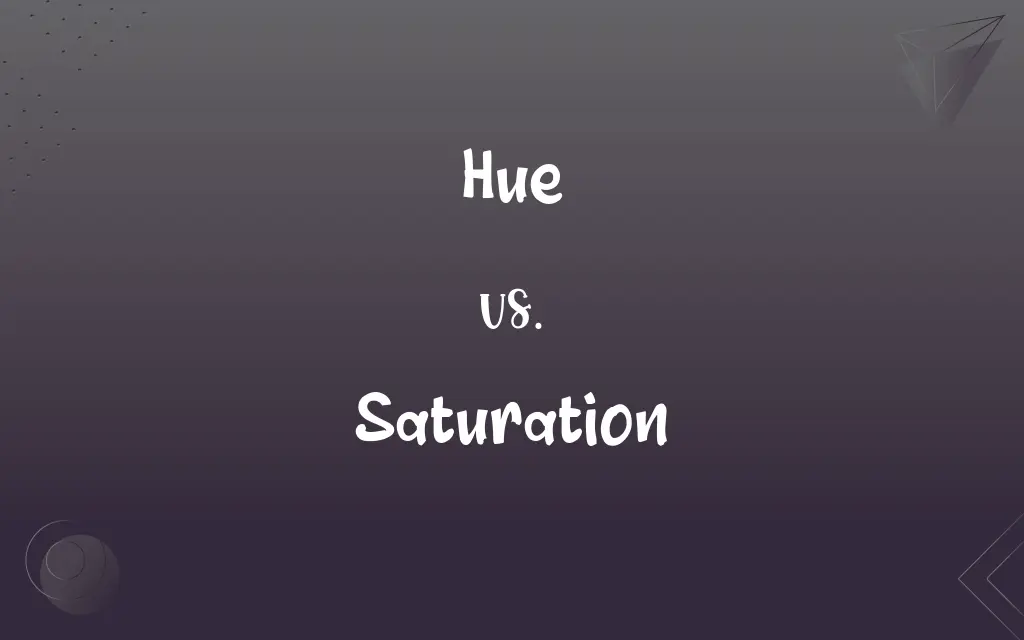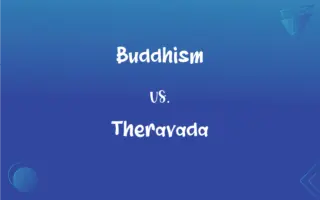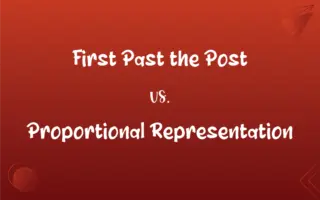Hue vs. Saturation: What's the Difference?
Edited by Janet White || By Harlon Moss || Published on December 14, 2023
Hue refers to the base color or shade in the color spectrum. Saturation indicates the intensity or purity of a color.

Key Differences
Hue represents the basic color perceived, such as red, blue, or green, essentially the aspect of color that is determined by the wavelength of light. Saturation, on the other hand, describes how vivid, rich, or intense a color is; it's the degree to which the hue differs from a neutral gray.
In the color spectrum, hue is identified as the position on the color wheel, distinguishing one color from another. Saturation measures the distance from the center of the color wheel, indicating how much a hue is diluted with white or black.
Hue is the aspect of color easily recognized and named, it is what makes a color identifiable as red, blue, etc. Saturation affects the vibrancy of the hue; high saturation means a color is vivid, while low saturation results in a more muted or washed-out color.
Changing the hue will result in a different color, whereas altering saturation changes the intensity of the same hue. High saturation colors are bold and bright, while low saturation can appear dull or faded.
Hue and saturation are key components in color theory and are essential in design, art, and photography to convey different moods and styles. While hue determines the color itself, saturation contributes to the visual impact and emotional response to that color.
ADVERTISEMENT
Comparison Chart
Definition
The base color or shade.
The intensity or purity of the color.
Color Spectrum Role
Determines position on the color wheel.
Measures distance from the wheel's center.
Effect on Color
Identifies color family (e.g., red, blue).
Affects vibrancy and richness of the hue.
Variation Impact
Changes the color itself.
Changes the intensity of the same color.
Visual Impact
Determines color identity.
Influences color's boldness and vividness.
ADVERTISEMENT
Hue and Saturation Definitions
Hue
Hue refers to a specific color or shade.
The painter chose a bright yellow hue for the sunset.
Saturation
Saturation describes the intensity of a color.
The saturation of the red was reduced to create a pink tone.
Hue
Hue represents a point on the color spectrum.
Her dress had a hue of lavender.
Saturation
Saturation indicates how muted or vivid a color is.
The photo's saturation was adjusted for a more natural look.
Hue
Hue is the aspect of color determined by wavelength.
Different hues like blue and red are visible in a rainbow.
Saturation
Saturation is the purity of a color without white or black.
Increasing the saturation made the blue more vivid.
Hue
Hue is the dominant wavelength of color.
He was fascinated by the rich hue of the sapphire.
Saturation
Saturation is the depth of color in its purest form.
High saturation in the painting made the colors pop.
Hue
Hue is the color family to which a shade belongs.
The hue of the leaves changed from green to orange in fall.
Saturation
Saturation measures the degree of color richness.
Lowering the saturation gave the image a subdued feel.
Hue
The property of colors by which they can be perceived as ranging from red through yellow, green, blue, and violet, as determined by the dominant wavelengths of the light being reflected, transmitted, or emitted. See Table at color.
Saturation
The act or process of saturating.
Hue
A particular gradation of color; a shade or tint.
Saturation
The condition of being saturated.
FAQs
What is hue in color?
Hue is the specific color or shade in the color spectrum.
Is hue the same as color?
Hue is a component of color, specifically the base color.
How is hue determined?
Hue is determined by the dominant wavelength of light.
How do you identify a hue?
Hue is identified as the color family it belongs to, like red or blue.
What happens when saturation is increased?
Increasing saturation makes colors more vivid and intense.
Can hue change the identity of a color?
Yes, changing hue results in a different color.
What does saturation refer to in color?
Saturation refers to the intensity or purity of a color.
Does hue have to do with light wavelength?
Yes, hue is related to the dominant wavelength of light.
How does saturation affect a color?
Saturation affects how vivid, rich, or muted a color appears.
Can saturation change the hue?
No, saturation changes the intensity, not the hue itself.
What role does saturation play in design?
Saturation determines the visual impact and mood of colors in design.
Does changing hue affect the entire color spectrum?
Changing hue shifts the position on the color wheel, affecting the color family.
Can two colors have the same hue but different saturations?
Yes, they can have the same hue but vary in intensity.
What is a desaturated color?
A desaturated color is one that has reduced intensity, appearing more muted.
Is saturation related to brightness?
No, saturation is about color intensity, while brightness is about lightness.
How does saturation affect mood in art?
High saturation can convey energy and vibrancy, while low saturation can evoke calmness or somberness.
How do hue and saturation affect color perception?
Hue determines what color is seen, while saturation affects how vivid or subdued the color appears.
Can hue be independent of saturation?
Yes, hue is an independent aspect of a color's identity.
Is a color without saturation still a hue?
Yes, but it would appear as a shade of gray.
Are hue and saturation always used together?
They are often considered together but can be manipulated independently in color design.
About Author
Written by
Harlon MossHarlon is a seasoned quality moderator and accomplished content writer for Difference Wiki. An alumnus of the prestigious University of California, he earned his degree in Computer Science. Leveraging his academic background, Harlon brings a meticulous and informed perspective to his work, ensuring content accuracy and excellence.
Edited by
Janet WhiteJanet White has been an esteemed writer and blogger for Difference Wiki. Holding a Master's degree in Science and Medical Journalism from the prestigious Boston University, she has consistently demonstrated her expertise and passion for her field. When she's not immersed in her work, Janet relishes her time exercising, delving into a good book, and cherishing moments with friends and family.






































































